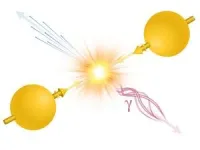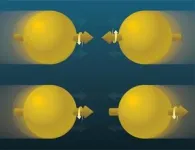(Press-News.org) UPTON, NY— A new publication by the PHENIX Collaboration at the Relativistic Heavy Ion Collider (RHIC) provides definitive evidence that gluon “spins” are aligned in the same direction as the spin of the proton they’re in. The result, just published in Physical Review Letters, provides theorists with new input for calculating how much gluons—the gluelike particles that hold quarks together within protons and neutrons—contribute to a proton’s spin.
Whether and how much gluons contribute to proton spin—an intrinsic angular momentum that’s associated with the protons’ optical, magnetic, and other properties—has been an open question since 1987. That’s when an experiment at Europe’s CERN laboratory revealed that quarks, the other components of protons and neutrons, cannot account for a proton’s total spin value.
“I was involved in the CERN experiment that established that quarks didn’t carry too much of the spin. That was a big surprise; it ignited a ‘spin crisis,’” said Abhay Deshpande, a physicist at Stony Brook University (SBU) and the U.S. Department of Energy’s (DOE) Brookhaven National Laboratory, where RHIC operates as a DOE Office of Science user facility for nuclear physicists from all over the world. “Obviously, the remaining spin had to come from somewhere else. So, at the time, there were ideas that gluons might carry the rest of the spin.”
The search for answers turned to Brookhaven Lab, where RHIC was taking shape to explore a different set of physics questions related to the way quarks and gluons existed in the early universe. But the spin mystery attracted a whole new set of collaborators—and significant contributions from Japan’s RIKEN laboratory—to expand RHIC’s capabilities. These included specialized accelerator components that allow RHIC to align and “flip” the spins of protons (making it the only polarized proton collider in the world), and additional equipment for making key spin measurements at the PHENIX experiment, one of RHIC’s first particle detectors.
“At the beginning of the RHIC project, we felt this is the place we must go,” said Hideto En’yo, a RIKEN physicist and one of the spokespersons of the first proposal for polarized proton acceleration at RHIC. “We were so excited when we realized that RHIC is polarizable, which enables us to resolve gluons’ role in the proton spin crisis.”
Brookhaven Lab accepted the proposal for the accelerator and detector additions, and RIKEN provided funding.
“In addition, because this was more than just participating in one experiment, RIKEN decided to establish the RIKEN-BNL Research Center (RBRC) to be RIKEN’s forward base and home at Brookhaven Lab for the experimentalists and theorists needed to pursue these questions,” En’yo said.
Golden measurement
The new PHENIX result is one of the “golden” measurements proposed as a key motivator for the RHIC spin physics program. It’s a comparison of the number of “direct photons” (particles of light) emitted when RHIC collides protons with their spins pointing in opposite directions (either at or away from each other) with the number of direct photons produced when the protons in the two beams are pointing in the same direction (colliding head to tail).
For reasons having to do with the way quarks and gluons can interact to emit photons (and knowing that net quark spins are positively aligned with proton spin), seeing a difference would indicate that gluon spins are also aligned, or polarized—and, importantly, in which direction. That is, the collision condition producing more direct photons would tell them whether the gluon spin alignment was positive—pointing in the same direction as the proton spin and contributing to that value—or negative (pointing in the opposite direction and counteracting the quarks’ contributions to spin).
“This is a very clean and simple result for interpretation,” said Brookhaven Lab physicist Alexander (Sasha) Bazilevsky, deputy spokesperson for the PHENIX Collaboration. “The beauty of the direct photons is that their production at RHIC is dominated by quark-gluon interactions,” he said. In other words, these particles of light come directly from the interaction of a quark in one proton beam with a gluon in the other—rather than from the decay of some other particle produced in the collision.
“And, when a photon is created, because it doesn’t carry any color charge [the form of charge that drives strong-force interactions among quarks and gluons] it doesn’t interact with the surrounding nuclear matter,” Deshpande said. “That’s what makes it such a clean measurement.”
But despite that apparent simplicity, “it’s pretty hard to measure experimentally,” Bazilevsky said.
The numbers game
One reason for the difficulty is that lots of other photons stream out of RHIC collisions. Finding those that come directly from quark-gluon interactions requires a systematic process of elimination.
“No other experiment or detector could do this measurement,” said Yasuyuki Akiba, a physicist at the RIKEN Nishina Center for Accelerator-Based Science, spokesperson for the PHENIX Collaboration, and Experiment Group Leader at the RBRC. “But because PHENIX had the most finely grained electromagnetic calorimeter (EMCal) ever built for a collider experiment, it provided the capabilities needed to separate out direct photons from those coming from other sources,” he explained.
For example, if a photon picked up in the detector is surrounded by other particles, it likely came from radiative processes that happened after the collision—so those photons are not direct. Likewise, if the energy and angles of a pair of photons can be reconstructed to have originated from the decay of a parent particle—a pi zero meson, say—then those photons are also not direct photons. After all the eliminations, the photons with no other obvious source are assumed to have originated from a quark-gluon scattering event.
To be left with enough direct photons for a proper statistical analysis after filtering out other photon-producing processes, the scientists also needed a very high number of collisions, or luminosity. When RHIC first started colliding polarized protons in the early 2000s, it didn’t have the numbers.
“Robert Bennett (now a data scientist in Washington, DC) was the first of my students to start working on this in the late 2000s, using analysis methods originally developed by Kensuke Okada of the RBRC and RIKEN,” Deshpande said. “The method worked, and we got preliminary results, but we didn’t have enough statistics to have a publication.”
Meanwhile PHENIX and STAR, RHIC’s other large detector, made other measurements related to gluon spin. STAR’s analysis of particle jets and PHENIX’s analysis of pi zero mesons showed that gluons were indeed polarized. “It was a big discovery,” Bazilevsky said.
But those measurements couldn’t reliably reveal the direction of the gluons’ spin alignment—whether it was along the direction of proton polarization or against it. In addition, because the particles tracked in those measurements do interact via the exchange of color charges, their signals were not as clean as the expected direct photon measurements.
Fortunately, the communities of experimental and accelerator physicists who were seeking to push RHIC to ever-higher levels of performance persevered.
“Many scientists—including those at RIKEN, the RBRC, and local Brookhaven Lab physicists Gerry Bunce of the Physics Department and Yousef Makdisi of C-AD—helped to push the program forward,” Deshpande said. “Sasha and I came in as young scientists/RBRC fellows, and they were the seniors who were mentoring us in every way.”
“And Thomas Roser [an accelerator physicist who later became Collider-Accelerator Department (C-AD) chair] was a big promoter of the spin program,” he added. “He understood how difficult it was. But he also understood that the challenge was exciting, and that new scientists would come here to take on the challenge—and that their efforts would improve the collider for the entire RHIC program.”
The investment paid off. By 2013, RHIC’s luminosity for both polarized proton and heavy ion collisions far exceeded the limits of its initial design. And innovative advances in accelerator physics had pushed the degree of polarization in the proton beams to nearly 60 percent.
Dedicated student(s) and experience
One more ingredient was still needed: a student willing to take on the complex analysis.
“When the luminosity and polarization of RHIC were coming up, it was to the credit of Zhongling Ji, who joined my group as a Stony Brook University graduate student in 2015 and understood how difficult this problem was, that he still jumped in and stuck with it,” Deshpande said.
The analysis progressed over Zhongling’s graduate career, extended a bit longer than a typical Ph.D. student’s work by the delays imposed by the COVID-19 pandemic.
“As noted, one of the major obstacles in this analysis is effectively removing the considerable background of photons that come from the decay of other particles produced in RHIC’s collisions,” said Ji, now a postdoctoral scholar at UCLA. “Our analysis built on the work of Okada and Bennett, as well as the contributions of Sasha and Sanghwa Park while she was a postdoc at Stony Brook (now a physicist at Thomas Jefferson National Accelerator Facility). They were heavily involved in the analysis. Where reconstructing photons resulting from the decay of other particles was not feasible, we instead relied on dedicated simulations to determine the frequency of these occurrences and carefully remove them from the data. That allowed us to zero in on a high enough number of direct photons to perform a statistically valid analysis.”
The results published in PRL are based on data collected in 2013, the last year high-energy longitudinally polarized protons were run while RHIC’s PHENIX detector was still collecting data. (PHENIX shut down in 2016 to make way for sPHENIX, RHIC’s brand new detector.) The data analyzed corresponds to about 5.4 trillion proton-proton collisions.
“In the end, it took five students over 15 years to complete this analysis,” said Deshpande, praising Zhongling’s dedication but also acknowledging the experience gained through those earlier efforts. “Everything all these students did was building toward this. It was all important work.”
The findings and the future
The PHENIX results show a clear difference in direct photon yields, with higher yields coming from the collisions where the proton spins are pointing in opposite directions (at or away from one another). This is clear evidence that the gluon spins are aligned in the same direction as the proton spin and make a significant contribution to the proton’s overall spin value. The new analysis will now provide input for theorists’ calculations to determine just how much of a contribution that is.
Does that finally solve the proton spin mystery? Not quite, the scientists say.
The final contribution to proton spin is likely the orbital motion of quarks and gluons within these composite particles. Those details are inaccessible in collisions of longitudinally polarized protons.
Collisions at RHIC where protons are collided with their spins pointing “up,” or transversely, have shown hints of the gluons’ orbital motion. But precision measurements of orbital motion will have to wait for the opening of the Electron-Ion Collider, a new facility for nuclear physics research that will be built by repurposing much of RHIC’s infrastructure.
The EIC will use polarized electron-proton collisions to measure the spin contribution of gluons with higher precision. These EIC experiments will improve significantly on the measurements that have been possible at RHIC in a complementary way. Furthermore, while RHIC gave excellent access to the highest “momentum fraction” gluons (those carrying a large fraction of the overall proton momentum), the EIC will give scientists access to low momentum fraction gluons. While these “low x” gluons each carry a small fraction of the overall proton momentum, they may make an outsized contribution to proton spin due to their relative abundance.
Bazilevsky noted how the EIC will bring the spin mystery full circle:
“The spin crisis started with deep inelastic scattering experiments at CERN in collisions of muons (cousins of electrons) on protons, which showed the quarks alone can’t account for spin. Then RHIC’s proton-proton experiments have revealed a lot about gluons. Now we will go back to electron-proton collisions at the EIC, with higher collision rates and both beams polarized, to finally solve this puzzle.”
This analysis was funded in part by the DOE Office of Science (NP) and the funders of individual members of the PHENIX collaboration as listed in the scientific paper. RHIC operations are funded by the DOE Office of Science (NP).
Brookhaven National Laboratory is supported by the Office of Science of the U.S. Department of Energy. The Office of Science is the single largest supporter of basic research in the physical sciences in the United States and is working to address some of the most pressing challenges of our time. For more information, visit science.energy.gov.
Follow @BrookhavenLab on Twitter or find us on Facebook.
Related Links
Scientific paper: "Measurement of Direct-Photon Cross Section and Double-Helicity Asymmetry at s√=510 GeV in p→ +p→ Collisions" END
Direct photons point to positive gluon polarization
Results from 'golden measurement' at RHIC's PHENIX experiment show the spins of gluons align with the spin of the proton they're in
2023-06-21
ELSE PRESS RELEASES FROM THIS DATE:
Mutant KRAS regulates Y chromosome gene in colorectal cancer, driving metastasis and inhibiting anti-tumor immunity
2023-06-21
HOUSTON ― Researchers at The University of Texas MD Anderson Cancer Center have uncovered a gene on the Y chromosome that is upregulated in KRAS-mutated colorectal cancer (CRC), increasing tumor cell invasiveness and reducing anti-tumor immunity in male patients.
The preclinical study, published today in Nature, provides novel insights into the longstanding mystery of molecular and cellular mechanisms that drive increased metastasis and poor prognosis in men with CRC. The results highlight the Y chromosome gene KDM5D, which codes for an epigenetic enzyme, as a potential therapeutic target and uncover ...
Conservation policies risk damaging global biodiversity, researchers argue
2023-06-21
‘Green’ farming policies may accelerate global biodiversity loss, two leading academics have warned.
Rewilding, organic farming and the ‘nature friendly farming’ measures included in some government conservation policies risk worsening the global biodiversity crisis by reducing how much food is produced in a region, driving up food imports and increasing environmental damage overseas.
In an article published today in the journal Nature, Professor Ian Bateman of the University of Exeter and Professor Andrew Balmford of the University of Cambridge urge policy-makers to consider a bolder approach known as ...
Stellenbosch University selects Symplectic Elements to support and streamline research outputs submissions to the DHET
2023-06-21
Digital Science, a technology company serving stakeholders across the research ecosystem, is pleased to announce that Stellenbosch University (SU) has selected Symplectic Elements from Digital Science’s flagship products to support its goal of advancing knowledge in service of society.
Symplectic Elements will provide SU with a Researcher Profiles and Research Outputs Management Solution, supporting and streamlining DHET (Department of Higher Education and Training) submissions and providing a public profiling system for its researchers.
SU is one of South Africa’s leading tertiary institutions, and is recognised internationally ...
Study proposes simple low-cost solutions to improve thermal comfort in social housing
2023-06-21
Brazil has a housing deficit of 5.876 million units (5.044 million in urban areas and 832,000 in rural areas), according to the latest government survey. The number corresponds to 8.1% of the nation’s total stock of private dwellings, permanent and improvised. To make good at least part of this huge social debt, the federal government launched a low-income housing program called Minha Casa Minha Vida (“My Home My Life”) in 2009.
However, funding was insufficient to meet demand of this size, and low investment allocated to construction of each unit resulted in problems such as lack of thermal comfort, a constant ...
National SFIREG meeting hosted at West Tennessee AgResearch and Education Center
2023-06-21
You may not think about the registration, distribution, sale and use of pesticide products that help control insects, weeds and diseases, but a lot of people in state and federal government do. They meet annually to discuss developments that can affect your health daily. From June 5-7, the State Federal Insecticide, Fungicide, and Rodenticide Act (FIFRA) Issues Research and Evaluation Group (SFIREG) hosted their national annual in-person meeting at the University of Tennessee’s West Tennessee AgResearch and Education Center in Jackson. ...
Equity in computer science impossible without review of curriculum, say researchers
2023-06-21
England’s girls and other underrepresented groups are at risk of being failed by the current computing curriculum, which excludes their interests, according to new research published recently.
A study by University of Reading, in partnership with Kings College London, published in the International Journal of Science Education, found the current school system creates a gender imbalance in computer science that is reflected in the workplace. The solution, they say, could ...
Blood pressure drug could prevent posttraumatic headaches
2023-06-21
A study led by VA Puget Sound Health Care System researchers has shown that prazosin, a drug used to treat high blood pressure, can prevent posttraumatic headaches.
Senior study author Dr. Murray Raskind, director of the VA Northwest Mental Illness Research, Education and Clinical Center in Seattle, Washington, explained that few treatment options exist for this type of headache.
“Persistent posttraumatic headaches are the most common long-term consequence of mild traumatic brain injuries (concussions) in Veterans and active-duty service members, causing substantial distress ...
Ketone supplements worsen performance in trained endurance athletes, researchers find
2023-06-21
Hamilton, ON, June 21, 2023 – Kinesiologists at McMaster University have found ketone supplements, used by some athletes hoping to cross the finish line faster, may in fact worsen performance.
The new study, published in the latest print edition of the International Journal of Sport Nutrition and Exercise Metabolism, tackles contradictory research findings related to the effectiveness of ketone supplements, which have gained popularity among athletes seeking a competitive advantage.
Some previously published studies had shown the supplements improve performance, while others have reported they had no effect or even worsened performance.
Natural ketones can ...
Exoplanet may reveal secrets about the edge of habitability
2023-06-21
ITHACA, N.Y. – How close can a rocky planet be to a star, and still sustain water and life? A recently discovered exoplanet may be key to solving that mystery.
“Super-Earth” LP 890-9c (also named SPECULOOS-2c) is providing important insights about conditions at the inner edge of a star’s habitable zone and why Earth and Venus developed so differently, according to new research led by Lisa Kaltenegger, associate professor of astronomy at Cornell University.
Her team found LP 890-9c, which orbits close to the inner ...
The art and science of living-like architecture
2023-06-21
“This technology is not alive,” says Laia Mogas-Soldevila. “It is living-like.”
The distinction is an important one for the assistant professor at the Stuart Weitzman School of Design, for reasons both scientific and artistic. With a doctorate in biomedical engineering, several degrees in architecture, and a devotion to sustainable design, Mogas-Soldevila brings biology to everyday life, creating materials for a future built halfway between nature and artifice.
The architectural technology she describes is unassuming ...
LAST 30 PRESS RELEASES:
Switching immune cells to “night mode” could limit damage after a heart attack, study suggests
URI-based Global RIghts Project report spotlights continued troubling trends in worldwide inhumane treatment
Neutrophils are less aggressive at night, explaining why nighttime heart attacks cause less damage than daytime events
Menopausal hormone therapy may not pose breast cancer risk for women with BRCA mutations
Mobile health tool may improve quality of life for adolescent and young adult breast cancer survivors
Acupuncture may help improve perceived breast cancer-related cognitive difficulties over usual care
Nerve block may reduce opioid use in infants undergoing cleft palate surgery
CRISPR primes goldenberry for fruit bowl fame
Mass General Brigham announces new AI company to accelerate clinical trial screening and patient recruitment
Fat tissue around the heart may contribute to greater heart injury after a heart attack
Jeonbuk National University researcher proposes a proposing a two-stage decision-making framework of lithium governance in Latin America
Chromatin accessibility maps reveal how stem cells drive myelodysplastic progression
Cartilaginous cells regulate growth and blood vessel formation in bones
Plant hormone allows lifelong control of proteins in living animal for first time
Swedish freshwater bacteria give new insights into bacterial evolution
Global measures consistently underestimate food insecurity; one in five who suffer from hunger may go uncounted
Hidden patterns of isolation and segregation found in all American cities
FDA drug trials exclude a widening slice of Americans
Sea reptile’s tooth shows that mosasaurs could live in freshwater
Pure bred: New stem cell medium only has canine components
Largest study of its kind highlights benefits – and risks – of plant-based diets in children
Synergistic effects of single-crystal HfB2 nanorods: Simultaneous enhancement of mechanical properties and ablation resistance
Mysterious X-ray variability of the strongly magnetized neutron star NGC 7793 P13
The key to increasing patients’ advance care medical planning may be automatic patient outreach
Palaeontology: Ancient tooth suggests ocean predator could hunt in rivers
Polar bears may be adapting to survive warmer climates, says study
Canadian wildfire smoke worsened pediatric asthma in US Northeast: UVM study
New UBCO research challenges traditional teen suicide prevention models
Diversity language in US medical research agency grants declined 25% since 2024
Concern over growing use of AI chatbots to stave off loneliness
[Press-News.org] Direct photons point to positive gluon polarizationResults from 'golden measurement' at RHIC's PHENIX experiment show the spins of gluons align with the spin of the proton they're in







